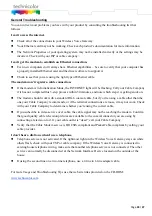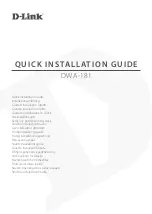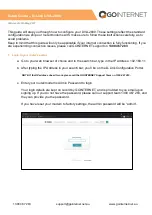
Page
26
/
27
Glossary
10/100/1000 BaseT
– Unshielded, twisted pair cable with an RJ-45 connector, used with Ethernet LAN
(Local Area Network). “10/100/1000” indicates speed (10/100/1000 BaseT), “Base” refers to baseband
technology, and “T” means twisted pair cable.
Authentication -
The process of verifying the identity of an entity on a network.
DHCP (Dynamic Host Control Protocol)
– A protocol which allows a server to dynamically assign IP
addresses to workstations on the fly.
Ethernet adapters
– A plug-in circuit board installed in an expansion slot of a personal computer. The
Ethernet card (sometimes called a Network Interface Card , network adapter or NIC) takes parallel data from
the computer, converts it to serial data, puts it into a packet format, and sends it over the 10/100/1000 BaseT
LAN cable.
DOCSIS (Data Over Cable Service Interface Specifications)
– A project with the objective of developing
a set of necessary specifications and operations support interface specifications for Cable Modems and
associated equipment.
F Connector
– A type of coaxial connector, labeled CABLE IN on the rear of the Wireless Voice Gateway
that connects the modem to the cable system.
HTTP (HyperText Transfer Protocol)
– Invisible to the user, HTTP is used by servers and clients to
communicate and display information on a client browser.
Hub
– A device used to connect multiple computers to the
Wireless Voice Gateway.
IP Address
– A unique, 32-bit address assigned to every device in a network. An IP (Internet Protocol)
address has two parts: a network address and a host address. This modem receives a new IP address from
your cable operator via DHCP each time it goes through Initialization Mode.
Key exchange
- The swapping of mathematical values between entities on a network in order to allow
encrypted communication between them.
MAC Address
– The permanent “identity” for a device programmed into the Media Access Control layer in
the network architecture during the modem’s manufacture.
NID
- Network Interface Device, the interconnection between the internal house telephone wiring and a
conventional telephone service provider’s equipment. These wiring connections are normally housed in a
small plastic box located on an outer wall of the house. It is the legal
demarcation
between
the
subscriber’s
property and the service provider’s property.
PacketCable
– A project with the objective of developing a set of necessary telephony specifications and
operations support interface specifications for
Wireless Voice Gateways and associated equipment used over
the DOCSIS based cable network.
PSTN (Public Switched Telephone Network)
– The worldwide voice telephone network which provides
dial tone, ringing, full-duplex voice band audio and optional services using standard telephones.
Provisioning
- The process of enabling the Media Terminal Adapter (MTA) to register and provide services
over the network.




































